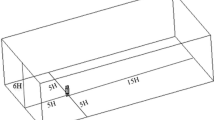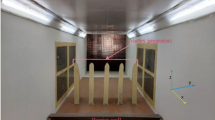Abstract
The paper discusses wind tunnel measurements performed on vertically placed rectangular prisms representing medium- and high-rise buildings. The results concern mean wind velocity pressure coefficient. The influences of the angle of wind attack, boundary layer and dimensions of models are considered. Two rectangular models of side ratio D/B = 2 (0.5) and two models of side ratio D/B = 4 (0.25) and different aspect ratios are investigated. Four cases of boundary layer flows are simulated. The prisms are examined at a full range of wind angles that change every 15°. Spatial distributions of the mean wind velocity pressure are similar between models and boundary layers at all angles of wind attack but differ significantly in values, especially on windward and side walls. The boundary layer characteristics have slightly stronger influence on the mean pressure coefficient on windward walls than the change in side ratio and dimensions of models. From the other hand, the change in model geometry influences suction a little stronger on leeward and side walls than the change of boundary layer. The wind action on windward wide wall causes greater differences of pressure on this wall and smaller differences of suction on side and leeward walls than the wind action on windward narrow wall. The oblique angles of wind attack cause greater suction at top parts of the models near the roof due to forming conical vortices.















Similar content being viewed by others
References
Baines WD, Effects of velocity distribution on wind loads and flow patterns on buildings, in: 1st Conf. Wind Eff. Build. Struct., National Physical Laboratory, Teddington, England, 1965: pp. 197–224.
Jensen M, Franck N, Model-scale tests in turbulent wind. Part 2. Phenomena dependent on the velocity pressure. Wind loads on buildings., The Danish Technical Press, Copenhagen, 1965.
Kareem A, Cermak JE. Pressure fluctuations on a square building model in boundary layer flows. J Wind Eng Ind Aerodyn. 1984;16:17–41. https://doi.org/10.1016/0167-6105(84)90047-3.
Surry D, Djakovich D. Fluctuating pressures on models of tall buildings. J Wind Eng Ind Aerodyn. 1995;58:81–112. https://doi.org/10.1016/0167-6105(95)00015-J.
Sitheeq MM, Iyengar AKS, Farell C. Effect of turbulence and its scales on the pressure field on the surface of a three-dimensional square prism. J Wind Eng Ind Aerodyn. 1997;69–71:461–71. https://doi.org/10.1016/S0167-6105(97)00177-3.
Kim Y, Kanda J. Characteristics of aerodynamic forces and pressures on square plan buildings with height variations. J Wind Eng Ind Aerodyn. 2010;98:449–65. https://doi.org/10.1016/j.jweia.2010.02.004.
Kim YC, Kanda J. Wind pressures on tapered and set-back tall buildings. J Fluids Struct. 2013;39:306–21. https://doi.org/10.1016/j.jfluidstructs.2013.02.008.
Wacker J. Towards reliability-based local design wind pressures for simple rectangularly-shaped buildings. J Wind Eng Ind Aerodyn. 1994;53:157–75. https://doi.org/10.1016/0167-6105(94)90024-8.
Liang S, Liu S, Li QS, Zhang L, Gu M. Mathematical model of acrosswind dynamic loads on rectangular tall buildings. J Wind Eng Ind Aerodyn. 2002;90:1757–70. https://doi.org/10.1016/S0167-6105(02)00285-4.
Liang S, Li QS, Liu S, Zhang L, Gu M. Torsional dynamic wind loads on rectangular tall buildings. Eng Struct. 2004;26:129–37. https://doi.org/10.1016/j.engstruct.2003.09.004.
Lin N, Letchford C, Tamura Y, Liang B, Nakamura O. Characteristics of wind forces acting on tall buildings. J Wind Eng Ind Aerodyn. 2005;93:217–42. https://doi.org/10.1016/j.jweia.2004.12.001.
Kareem A. Measurements of pressure and force fields on building models in simulated atmospheric flows. J Wind Eng Ind Aerodyn. 1990;36:589–99. https://doi.org/10.1016/0167-6105(90)90341-9.
K. Butler, A. Kareem, Characteristics of pressure and integral loads on prisms in boundary layer flows. In: Proceedings of 12th International Conference on Wind Eng., 2007; pp. 487–494.
Tamura Y, Kikuchi H, Hibi K. Peak normal stresses and effects of wind direction on wind load combinations for medium-rise buildings. J Wind Eng Ind Aerodyn. 2008;96:1053–7. https://doi.org/10.1016/j.jweia.2007.06.027.
Cheng CM, Tsai MS, Along-wind design wind load for tall buildings (I): Results of wind tunnel tests, in: Proc. 5th Int. Adv. Sch. Wind Eng., The GCOE Program at Tokyo Polytechnic University, 2009; pp. 5–29.
Zhang J, Gu M. Distribution of background equivalent static wind load on high-rise buildings. Front Archit Civ Eng Chin. 2009;3:241–8. https://doi.org/10.1007/s11709-009-0036-z.
Bartoli G, Ricciardelli F. Characterisation of pressure fluctuations on the leeward and side faces of rectangular buildings and accuracy of the quasi-steady loads. J Wind Eng Ind Aerodyn. 2010;98:512–9. https://doi.org/10.1016/j.jweia.2010.04.001.
Quan Y, Liang Y, Wang F, Gu M. Wind tunnel test study on the wind pressure coefficient of claddings of high-rise buildings. Front Archit Civ Eng Chin. 2011;5:518–24. https://doi.org/10.1007/s11709-011-0128-4.
Amin JA, Ahuja AK. Effects of side ratio on wind-induced pressure distribution on rectangular buildings. J Struct. 2013;2013:1–12. https://doi.org/10.1155/2013/176739.
Amin JA, Ahuja AK. Characteristics of wind forces and responses of rectangular tall buildings. Int J Adv Struct Eng. 2014;6:1–14. https://doi.org/10.1007/s40091-014-0066-1.
Ganapathi CS, Harikrishna P, S.R. S, Effects of upstream terrain characteristics on aerodynamic coefficients of structures. Arch Civ Mech Eng 2017; 17:776–785. https://doi.org/10.1016/j.acme.2017.02.005.
Lee BE. The effect of turbulence on the surface pressure field of a square prism. J Fluid Mech. 1975;62:263–82. https://doi.org/10.1017/S0022112075001437.
A.R. Barriga, C.T. Crowe, J.A. Robertson, Pressure distribution of a square cylinder at a small angle of attack in a turbulent cross flow, in: Proc. 4th Int. Conf. Wind Eff. Build. Struct., London, UK, 1975: pp. 89–93.
M. Miyazaki, T. Miyata, Effect of turbulence scale on aerodynamic response of rectangular cylinders, in: 5th Symp. Wind Eff. Struct., 1978.
S. Yawei, The effects of turbulence on the aerodynamic properties pf two-dimensional rectangular cylinders, in: Recent Advences Wind Eng. Proc. 2nd Asia-Pacific Symp. Wind Eng., Beijing, China, 1989: pp. 340–347.
Q.S. Li, W.H. Melbourne, Effects of turbulence on surface pressures of the flat plate and rectangular cylinders in separated and reattaching flows, in: 9th Interntational Conf. Wind Eng., New Delhi, India, 1995: pp. 165–176.
Yu D, Kareem A. Two-dimensional simulation of flow around rectangular prisms. J Wind Eng Ind Aerodyn. 1996;62:131–61. https://doi.org/10.1016/S0167-6105(96)00076-1.
Yu D, Kareem A. Parametric study of flow around rectangular prisms using LES. J Wind Eng Ind Aerodyn. 1998;77:653–62. https://doi.org/10.1016/S0167-6105(98)00180-9.
Lu PC, Cheng CM, The development of separated shear layers of rectangular prisms in turbulent flows. In: A. Larsen, G. Larose, F. Livesey (Eds.), Wind Eng. into 21st Century, Balkema, Rotterdam, 1999; pp. 1693–1698.
Shimada K, Ishihara T. Application of a modified k-e model to the prediction of aerodynamic characteristics of rectangular cross-section cylinders. J Fluids Struct. 2002;16:465–85. https://doi.org/10.1006/jfls.2001.0433.
Tamura T, Ono Y. LES analysis on aeroelastic instability of prisms in turbulent flow. J Wind Eng Ind Aerodyn. 2003;91:1827–46. https://doi.org/10.1016/j.jweia.2003.09.032.
Noda H, Nakayama A. Free-stream turbulence effects on the instantaneous pressure and forces on cylinders of rectangular cross section. Exp Fluids. 2003;34:332–44. https://doi.org/10.1007/s00348-002-0562-0.
Chen JH, Chen DH, The surface pressures of 2–D rectangular cylinder with small angle of oncoming flow. In: J. Naprstek, C. Fischer (Eds.), Proc. 4th Eur. Conf. Wind Eng., Praque, Czech Republic, 2005.
Melbourne WH. Comparison of measurements on the CAARC standard tall building model in simulated model wind flows. J Wind Eng Ind Aerodyn. 1980;6:73–88. https://doi.org/10.1016/0167-6105(80)90023-9.
Tanaka H, Lawen N. Test on the CAARC standard tall building model with a length scale 1:1000. J Wind Eng Ind Aerodyn. 1986;26:15–29. https://doi.org/10.1016/0167-6105(86)90102-9.
Goliger AM, Milford RV. Sensitivity of the CAARC standard building model to geometric scale and turbulence. J Wind Eng Ind Aerodyn. 1988;31:105–23. https://doi.org/10.1016/0167-6105(88)90190-0.
Huang S, Li QS, Xu S. Numerical evaluation of wind effects on a tall steel building by CFD. J Constr Steel Res. 2007;63:612–27. https://doi.org/10.1016/j.jcsr.2006.06.033.
Huang MF, Lau IWH, Chan CM, Kwok KCS, Li G. A hybrid RANS and kinematic simulation of wind load effects on full-scale tall buildings. J Wind Eng Ind Aerodyn. 2011;99:1126–38. https://doi.org/10.1016/j.jweia.2011.09.003.
Daniels SJ, Castro IP, Xie ZT. Peak loading and surface pressure fluctuations of a tall model building. J Wind Eng Ind Aerodyn. 2013;120:19–28. https://doi.org/10.1016/j.jweia.2013.06.014.
Meng FQ, He BJ, Zhu J, Zhao DX, Darko A, Zhao ZQ. Sensitivity analysis of wind pressure coefficients on CAARC standard tall buildings in CFD simulations. J Build Eng. 2018;16:146–58. https://doi.org/10.1016/j.jobe.2018.01.004.
Thordal MS, Bennetsen JC, Koss HHH. Review for practical application of CFD for the determination of wind load on high-rise buildings. J Wind Eng Ind Aerodyn. 2019;186:155–68. https://doi.org/10.1016/j.jweia.2018.12.019.
Li Y, Li C, Li QS, Song Q, Huang X, Li YG. Aerodynamic performance of CAARC standard tall building model by various corner chamfers. J Wind Eng Ind Aerodyn. 2020;202: 104197. https://doi.org/10.1016/j.jweia.2020.104197.
Kikuchi H, Tamura Y, Ueda H, Hibi K. Dynamic wind pressures acting on a tall building model – proper orthogonal decomposition. J Wind Eng Ind Aerodyn. 1997;69–71:631–46. https://doi.org/10.1016/S0167-6105(97)00193-1.
Maruta E, Kanda M, Sato J. Effects on surface roughness for wind pressure on glass and cladding of buildings. J Wind Eng Ind Aerodyn. 1998;74–76:651–63. https://doi.org/10.1016/S0167-6105(98)00059-2.
Tamura T, Nozawa K, Kondo K. AIJ guide for numerical prediction of wind loads on buildings. J Wind Eng Ind Aerodyn. 2008;96:1974–84. https://doi.org/10.1016/j.jweia.2008.02.020.
Butler K, Cao S, Kareem A, Tamura Y, Ozono S. Surface pressure and wind load characteristics on prisms immersed in a simulated transient gust front flow field. J Wind Eng Ind Aerodyn. 2010;98:299–316. https://doi.org/10.1016/j.jweia.2009.11.003.
Tanaka H, Tamura Y, Ohtake K, Nakai M, Kim YC. Experimental investigation of aerodynamic forces and wind pressures acting on tall buildings with various unconventional configurations. J Wind Eng Ind Aerodyn. 2012;107–108:179–91. https://doi.org/10.1016/j.jweia.2012.04.014.
Maruyama Y, Tamura T, Okuda Y, Ohashi M. LES of fluctuating wind pressure on a 3D square cylinder for PIV-based inflow turbulence. J Wind Eng Ind Aerodyn. 2013;122:130–7. https://doi.org/10.1016/j.jweia.2013.07.001.
Montazeri H, Blocken B. CFD simulation of wind-induced pressure coefficients on buildings with and without balconies: Validation and sensitivity analysis. Build Environ. 2013;60:137–49. https://doi.org/10.1016/j.buildenv.2012.11.012.
Ricci M, Patruno L, Kalkman I, de Miranda S, Blocken B. Towards LES as a design tool: Wind loads assessment on a high-rise building. J Wind Eng Ind Aerodyn. 2018;180:1–18. https://doi.org/10.1016/j.jweia.2018.07.009.
Sheng R, Perret L, Calmet I, Demouge F, Guilhot J. Wind tunnel study of wind effects on a high-rise building at a scale of 1:300. J Wind Eng Ind Aerodyn. 2018;174:391–403. https://doi.org/10.1016/j.jweia.2018.01.017.
Li Y, Tian X, Tee KF, Li QS, Li YG. Aerodynamic treatments for reduction of wind loads on high-rise buildings. J Wind Eng Ind Aerodyn. 2018;172:107–15. https://doi.org/10.1016/j.jweia.2017.11.006.
Liu Y, Kopp GA, Chen S. Effects of plan dimensions on gust wind loads for high-rise buildings. J Wind Eng Ind Aerodyn. 2019;194: 103980. https://doi.org/10.1016/j.jweia.2019.103980.
Hui Y, Yuan K, Chen Z, Yang Q. Characteristics of aerodynamic forces on high-rise buildings with various façade appurtenances. J Wind Eng Ind Aerodyn. 2019;191:76–90. https://doi.org/10.1016/j.jweia.2019.06.002.
Chen Z, Tse KT, Kwok KCS. Unsteady pressure measurements on an oscillating slender prism using a forced vibration technique. J Wind Eng Ind Aerodyn. 2017;170:81–93. https://doi.org/10.1016/j.jweia.2017.08.004.
Zeng J, Li M, Li S, Ma R. Spatial distribution of gusty loads on a rectangular prism in boundary layer flows. KSCE J Civ Eng. 2018;22:3052–65. https://doi.org/10.1007/s12205-017-0465-5.
Flaga A, Kłaput R, Augustyn M. Wind tunnel tests of two free-standing lighting protection masts in different arrangements with surroundings roof objects and roof conditions. Eng Struct. 2016;124:539–48. https://doi.org/10.1016/j.engstruct.2016.06.040.
Kocoń A, Flaga A. Critical velocity measurements of freight railway vehicles roll-over in wind tunnel tests as the method to assess their safety at strong cross winds. J Wind Eng Ind Aerodyn. 2021. https://doi.org/10.1016/j.jweia.2021.104559.
Bęc J, Lipecki T, Błazik-Borowa E. Research on wind structure in the wind tunnel of Wind Engineering Laboratory of Cracow University of Technology. J Phys Conf Ser. 2011;318: 072003. https://doi.org/10.1088/1742-6596/318/7/072003.
Lipecki T, Błazik-Borowa E, Bęc J, Wind structure influence on surface pressures of rectangular cylinders at various angles of wind attack, in: 13th Int. Conf. Wind Eng., Multi-Science Publishing Co Ltd, Amsterdam, Netherlands, 2011; p. CD, #272.
Lipecki T, Bęc J, Błazik-Borowa E, The response of aeroelastic models of circular cross-sections to wind action. In: H. Xiang, Y. Ge, S. Cao (Eds.), 7th Int. Colloq. Bluff Bodies Aerodyn. Appl., China Communications Audio-Visual & Electronic Press, Shanghai, China, 2012: pp. 573–582.
Holmes JD. Wind loading of structures. New York: CRC Press; 2015.
Author information
Authors and Affiliations
Corresponding author
Ethics declarations
Conflict of interest
Author declares that he has no conflict of interest.
Ethical approval
This article does not contain any studies with human participants or animals performed by the author.
Additional information
Publisher's Note
Springer Nature remains neutral with regard to jurisdictional claims in published maps and institutional affiliations.
Rights and permissions
About this article
Cite this article
Lipecki, T. Pressure distribution on rectangular tall buildings in boundary layer flows. Archiv.Civ.Mech.Eng 22, 83 (2022). https://doi.org/10.1007/s43452-022-00398-5
Received:
Revised:
Accepted:
Published:
DOI: https://doi.org/10.1007/s43452-022-00398-5




